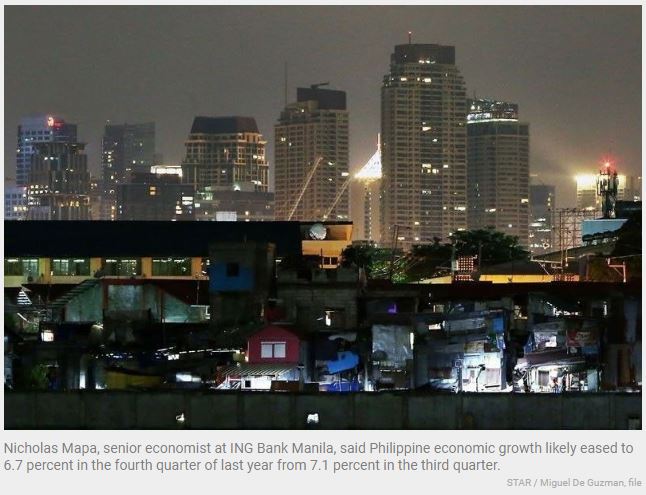Philippines: ING sees slower 6.7% GDP growth in Q1
MANILA, Philippines — Philippines economic growth likely slowed in the fourth quarter of last year as the damage caused by Typhoon Odette sapped the gains from relaxed COVID restrictions, according to Dutch financial giant ING Bank.
Nicholas Mapa, senior economist at ING Bank Manila, said Philippine economic growth likely eased to 6.7 percent in the fourth quarter of last year from 7.1 percent in the third quarter.
“And although the storm damage from super Typhoon Odette will likely take some shine off economic recovery, the sheer pickup in activity in the capital region will likely be enough to power the fourth quarter 2021 GDP to 6.7 percent,” Mapa said.
He said declining COVID case counts from October to December resulted in relaxed restrictions amid the holiday cheer, spurring revenge spending in the fourth quarter.
As a result, ING said the Philippines likely ended 2021 with a GDP growth of 5.4 percent, reversing the 9.6 percent contraction in 2020 when the country slipped into recession, as the economy stalled due to strict lockdown and quarantine measures.
“After two COVID surges, Philippine GDP will likely settle at 5.4 percent for 2021, at the upper-end of the twice downgraded growth target, but also more than a full percentage point lower than the original growth aspiration,” Mapa said.
Economic managers, through the Development Budget Coordination Committee (DBCC), earlier raised their GDP growth forecast to a range of five to 5.5 percent for 2021 after the country emerged from the pandemic-induced recession with a back-to-back expansion of 12 percent in the second quarter and 7.1 percent in the third quarter last year.
At the start of 2022, the National Capital Region (NCR) and several provinces were elevated to Alert Level 3 as COVID cases hit daily record levels due to the more contagious Omicron variant.
“Revenge spending and the holiday cheer came to an abrupt halt as COVID cases began to accelerate sharply to close out 2021. 2022 greeted us with cases hitting new highs, as infections spread rapidly in areas that had high mobility during the Christmas season,” Mapa said.
He explained mobility metrics associated with brisk economic activity have fallen sharply, as Filipinos are either isolating sick at home or are too anxious of catching the virus.
Likewise, he said thousands of workers who caught the virus either at the workplace or through close contacts are out of commission, resulting in lower or no productivity.
“All these disruptions may be overcome, but we need to brace for a potential pullback in expectations and sentiment from both firms and consumers alike. Both these two metrics had shown some promise to close out 2021 and we can expect a potential reversal in these trends come first quarter of 2022,” Mapa said.
The DBCC expects a faster GDP growth of seven to nine percent this year.
“All these disruptions, coupled with the fact that we will no longer benefit from a favorable base, suggest that the seven to nine percent growth aspiration may need to be revisited after all this is said and done,” Mapa said.
According to the economist, authorities have been quick to downplay the impact of the latest surge in cases, pointing to lower hospitalization rates and severity of cases.
For one, Bangko Sentral ng Pilipinas Governor Benjamin Diokno earlier downplayed the impact of the more contagious but less lethal Omicron variant, as the country is likely to deliver on the promised seven to nine percent GDP growth this year.
“Officials are also extra confident of still achieving the seven to nine percent growth target this year, pointing to past experiences where GDP managed to crest seven percent during a similar surge. And although metrics do suggest a lower hospitalization rate so far, one can’t dismiss the fact that the recovery momentum has been disrupted by the current spike in cases,” Mapa said.
Source: https://www.philstar.com/business/2022/01/19/2154764/ing-sees-slower-67-gdp-growth-q1


 English
English




